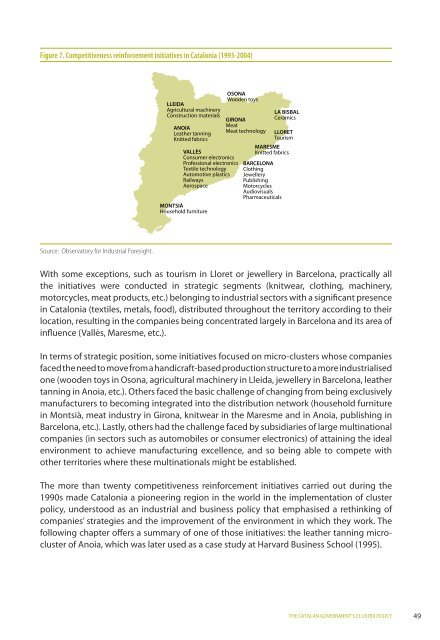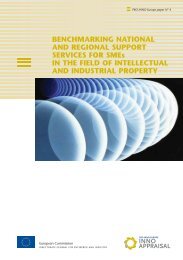Clusters and competitiveness - PRO INNO Europe
Clusters and competitiveness - PRO INNO Europe
Clusters and competitiveness - PRO INNO Europe
Create successful ePaper yourself
Turn your PDF publications into a flip-book with our unique Google optimized e-Paper software.
Figure 7. Competitiveness reinforcement initiatives in Catalonia (1993-2004)<br />
Source: Observatory for Industrial Foresight.<br />
LLEIDA<br />
Agricultural machinery<br />
Construction materials<br />
ANOIA<br />
Leather tanning<br />
Knitted fabrics<br />
VALLÈS<br />
Consumer electronics<br />
Professional electronics<br />
Textile technology<br />
Automotive plastics<br />
Railways<br />
Aerospace<br />
MONTSIÀ<br />
Household furniture<br />
OSONA<br />
Wooden toys<br />
GIRONA<br />
Meat<br />
Meat technology<br />
LA BISBAL<br />
Ceramics<br />
LLORET<br />
Tourism<br />
MARESME<br />
Knitted fabrics<br />
BARCELONA<br />
Clothing<br />
Jewellery<br />
Publishing<br />
Motorcycles<br />
Audiovisuals<br />
Pharmaceuticals<br />
With some exceptions, such as tourism in Lloret or jewellery in Barcelona, practically all<br />
the initiatives were conducted in strategic segments (knitwear, clothing, machinery,<br />
motorcycles, meat products, etc.) belonging to industrial sectors with a significant presence<br />
in Catalonia (textiles, metals, food), distributed throughout the territory according to their<br />
location, resulting in the companies being concentrated largely in Barcelona <strong>and</strong> its area of<br />
influence (Vallès, Maresme, etc.).<br />
In terms of strategic position, some initiatives focused on micro-clusters whose companies<br />
facedtheneedtomovefromah<strong>and</strong>icraft-basedproductionstructuretoamoreindustrialised<br />
one (wooden toys in Osona, agricultural machinery in Lleida, jewellery in Barcelona, leather<br />
tanning in Anoia, etc.). Others faced the basic challenge of changing from being exclusively<br />
manufacturers to becoming integrated into the distribution network (household furniture<br />
in Montsià, meat industry in Girona, knitwear in the Maresme <strong>and</strong> in Anoia, publishing in<br />
Barcelona, etc.). Lastly, others had the challenge faced by subsidiaries of large multinational<br />
companies (in sectors such as automobiles or consumer electronics) of attaining the ideal<br />
environment to achieve manufacturing excellence, <strong>and</strong> so being able to compete with<br />
other territories where these multinationals might be established.<br />
The more than twenty <strong>competitiveness</strong> reinforcement initiatives carried out during the<br />
1990s made Catalonia a pioneering region in the world in the implementation of cluster<br />
policy, understood as an industrial <strong>and</strong> business policy that emphasised a rethinking of<br />
companies’ strategies <strong>and</strong> the improvement of the environment in which they work. The<br />
following chapter offers a summary of one of those initiatives: the leather tanning microcluster<br />
of Anoia, which was later used as a case study at Harvard Business School (1995).<br />
THE CATALAN GOVERNMENT’S CLUSTER POLICY<br />
49
















